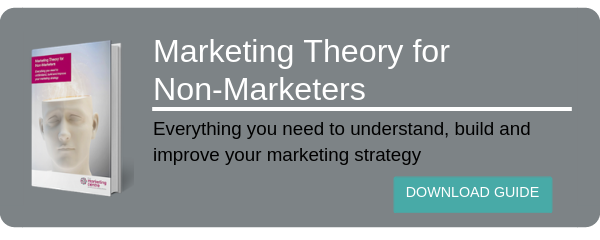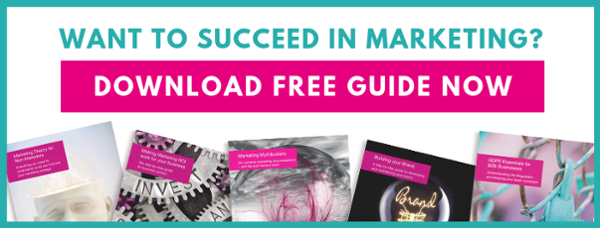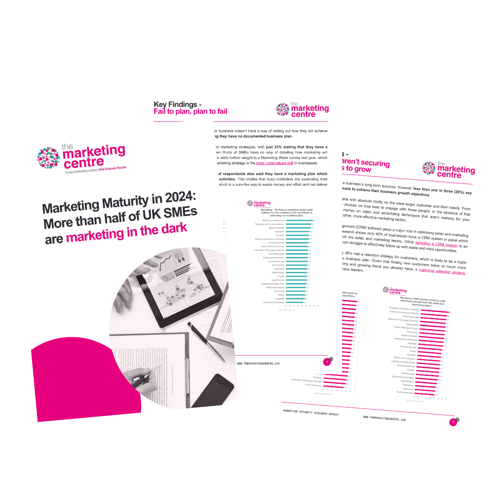Marketing innovates, tests and refines ideas that increase your business’ presence in the marketplace, making more prospective customers more aware of who you are and what you do. It also brings customers into your business, guides them to the point where they’re willing to spend money, and keeps them there and spending for as long as possible. All of these fit into our Marketing 360 framework - they’re all goals and activities which are part of one overarching function, and it’s all directed toward growth.
This guide is all about how marketing does that. We’ll take you through the steps, starting with your value proposition (what you have to offer your customers) and segmentation (who’s going to buy it, and the best way to encourage them).
We’ll look at ensuring your sales and marketing people are working together, how marketing generates and nurtures leads ready for the sales team to close the deal, how to manage the process and pick the right tools to monitor and measure success.
Then it’s time to optimise - how to accelerate your sales pipeline for a short-term growth boost, and sustain that growth by retaining and developing your customers, boosting their lifetime value by keeping them spending and advocating for as long as you can.
So without further ado...
1. Creating a value proposition
A value proposition is a precise summary of the pain points you resolve for customers. How do your services or products alleviate their problems? Why should they choose your business and not your competitors?
It’s created for internal use, providing direction for your team in all areas of marketing and communications. It informs your external-facing copy, content and other marketing activities. Crafting it means you have to think about what your customers need - and that insight is crucial not just for marketing, but for the business as a whole.
Our value proposition template
The content of a value proposition needs to summarise the following facts about your business in half a page or so:
- The pain your customers suffer, and their business goals
- The products and services you offer to solve that pain and meet those goals
- Key reasons your target customers should buy products and services from you, and not from a competitor
This focus on what you can do for your customers ensures your messaging will stay consistent and consistently relevant. The key to growth here is to drive up the value of your service or product by thinking about how you help customers do what they do well.

If you run an airline, you’re not just flying people back and forth. You’re enabling them to do things - travel to conferences, go on holiday, reunite with family half a world away. If you’re selling a cybersecurity suite, what you’re actually selling people is an easier way to protect the data they handle and reassure their customers that they’re taking good care. That’s their goal, and your offering helps them get there.
Your value proposition is that you add value to your customers’ businesses, so quantify that value; if you’re helping customers save time, you need to know how much time you save. Even if you don’t pass that exact figure on to the customer, it’ll inspire and focus your future messages.
A strong, clear value proposition can make all the difference. Unbounce offers landing page optimisation and A/B testing for websites - a technical service which, to a non-IT person, can sound quite abstract. Their value proposition shines through in everything on their website - every aspect of their service is described in terms of what good it does for the customer. Better landing pages mean better quality scores, which mean lower costs per click and better returns on pay-per-click advertising. You can see the pain point - “I’m spending too much on PPC” - and Unbounce spells out a solution to it without bogging you down in the details.
2. Use segmentation to help focus your marketing spend
A market segment is made up of customers who buy the same things, for the same reason, in the same way (and possibly at the same time).
As soon as things start to change - buying at a physical location rather than online, or buying a product for a job rather than a hobby - you've got a different segment. In this way, a business may well have different segments for the same product, or the same segment for multiple products.
"A business may well have different segments for the same product, or the same segment for multiple products."
Segmentation helps growth by focusing marketing spend and marketing activity on the customers where it will do the most work and induce the most business. Even the smartest and savviest of businesses can stand to save money and improve growth through segmentation, by concentrating their efforts on the customers who are most likely to buy.
A business which understands its audience, and targets its marketing campaigns at them, improves their cost per acquisition rate, ensuring that their resources aren’t spread too thinly, and that their returns will exceed their investment.
How to segment your marketplace
At a basic level, creating a market segment involves finding the common characteristics in current customers, then finding potential customers who share those characteristics.
Let’s go back to our cybersecurity provider from the last section. Say they supply SMEs with a turnover of between two and ten million pounds, and their customer database already covers 85% of the businesses in the region where they operate. There will come a time when their target segment - the two to ten million pound businesses - will be exhausted.
If you have exhausted your target segment, you have three choices to ensure continued business growth:
- Find a new region to operate in
- Target your services to larger businesses
- Create a new product to sell to existing customers
Option one involves creating a new segment for the new region: the firm would have to invest in expanding their operational infrastructure and may need a new marketing approach, defined by market research into the existing contacts and similar businesses in the target market.
Option two may demand new marketing tactics - larger businesses have different pain points.
Option three may involve subdividing their existing segment, looking for ways to present a new product - expanding from securing networks into providing a whole computer system with their security tech built-in and pre-installed.
Segmentation and email marketing
Segmentation is the strategic basis for tactical activities - once you’ve established your market segments, the rest of your marketing is built to target them in the right ways. For example, segmentation drives effective email marketing. Sorting your client or customer base by industry and job title is a good start - people with similar roles or in similar fields likely have similar problems that you can solve.
 As you discover more about the people with whom you do business, you can sub-segment, finding more specific common points between smaller groups of customers - how they use a particular product, when they enquire about new service options and what drives them to go looking.
As you discover more about the people with whom you do business, you can sub-segment, finding more specific common points between smaller groups of customers - how they use a particular product, when they enquire about new service options and what drives them to go looking.
The goal isn’t to sort all your customers out into neat little stacks with no crossover whatsoever: it’s to find the right targets for your messaging and cross-sell services or products to people who are most likely to buy them. You have a 60-70% chance of selling to an existing customer, compared to 5-20% of selling to a new prospect. Putting together things you frequently sell together, and offering them to the kind of people who frequently buy them together, becomes a recipe for solid, sustainable business growth.
3. Communication channels and routes to market
You have your value proposition, so you know what to say. You have your market segment, so you know who you’re saying it to. Now you need to decide how best to say it, and how to carry out the sale. The big thing here? Go to where your customers are. Market research into your target segments will help you narrow down the range of communication channels and routes to market available - and making the choice of which to prioritise is all about testing, measuring and optimising.
Choosing the right communication channel
Channels are the media by which you get your message across: direct mail, print media, posters, email, social media and so on. Some split down further - there’s a difference between an event invitation and a catalogue, or between LinkedIn and Twitter. At its most basic, this is a simple choice to make. Look at where your customers congregate, what they read, and which networks they trust. Go there and speak to them.

The choice of channel matters because no successful sale is based on one touchpoint - one interaction between customer and brand. Customers decide to buy after multiple contacts. How many is up for debate - some self-proclaimed authorities say three, others seven - the point, however, is that customer attention is an S-curve, dropping for a while and then rising with repeated exposure to a business’ marketing messages.
To ensure growth, you need to measure Return On Investment for every marketing channel you use. There’s no point going to every trade show in your sector, no matter how much you enjoy conference centre coffee, if you can have the same conversations with prospective customers in webinars or consultations at a fraction of the cost and still get sales. On the flipside, it doesn’t matter if your direct mail costs twice what your telemarketing does, as long as it’s earning three times as much.
Growth is about getting your money’s worth - not cutting costs.
Example: Instagram
If you had to name the most important social media platform for B2B businesses - be honest now - would you say Instagram? A picture-driven platform that’s all about personal expression and creativity (or sharing pictures of your coffee) might seem like a B2C kind of place, but recent live questioning by SocialMediaToday suggests that brands with a story to tell can use Instagram’s Story and Bio features to put that story front and centre. It’s the right platform for a particular message.
The point isn’t to use Instagram’s built-in sales tools to actually carry out transactions on the platform - it’s to humanise the brand, putting faces and names to values and responding to user-generated content, creating another touchpoint that nudges customers toward buying again.
Routes to market
It’s not just what you sell that matters - it’s where and how you sell it. Whether you opt for direct sales, Amazon, your own e-commerce platform or over the phone depends on what works for your customer. As with communication channels, the right routes to market are the ones your customers - current and potential - prefer to use.
And like communication channels, it pays to diversify. You may have always arranged consultations over the phone, and made sales in a face to face meeting, but if your market research indicates that newer businesses buy services and products like yours online, there’s a whole market segment you’re missing out on. If your business is hitting a growth plateau, diversifying your routes to market can be the catalyst that gets you going uphill again.
4. Make the most of your sales and marketing leads
Lead generation is part of the marketing function. A small part. But without proper customer management, and alignment with the sales team, seven out of ten generated leads go to waste - it’s activity that doesn’t translate into business growth.
Marketing defines the customers you’re looking for, at the market research and segmentation stages. It finds the potential customers among those segments - that’s the lead generation part. Then it aligns with the sales function, by creating further touchpoints that warm the leads up and guide them toward the point of purchase. And finally, it steps in to provide after-sales efforts that keep the customer engaged and willing to purchase again, looking for the cross-sale opportunities that power business growth. These opportunities are seriously powerful, for businesses of any size - cross-selling accounts for 35% of Amazon’s sales volume.
This isn’t to say that lead generation isn’t important in growing your business. It absolutely is. But the key question isn’t “how can I generate more leads?” - it’s “how I can I get the most out of the leads I have?”
How to qualify a lead
It’s important to find out how valuable each prospect is, applying a rubric to qualify the leads and prioritising the ones who are most likely to buy. The classic lead generation rubric BANT sorts your leads by:
- Budget - can the prospect afford what you’re selling?
- Authority - is the purchase decision theirs to make?
- Need - have you established why they need your service or product?
- Timescale - is the lead close to deciding to buy?
The leads who’ll bring you profit in the short term are those who tick all four boxes, but growth demands awareness of where all your leads lie in these terms, and what kind of marketing activity will bring them closer to buying.
5. Align your sales and marketing teams
Business leaders tend to put a premium on sales - after all, sales generate revenue and revenue drives growth, right? Right: but only so far. Business growth depends on a functional relationship between sales and marketing.
At some point, marketing hands over prospective customers to sales. Hand over too soon, and sales end up with an unqualified lead - a customer who’s not ready, willing, or able to buy. Leave it too late, and marketing goes past the sale, putting a customer off purchase. In either case, the business as a whole will stagnate.
Understanding when’s “too soon” and when’s “too late” is the first step toward sales alignment. This is why the teams need to work together, and sit down to define what a lead actually is and when that lead is in the right state to be handed over.
"Understanding when’s “too soon” and when’s “too late” is the first step toward sales alignment."
To ensure sustained business growth, sales need quality leads - but they also need realistic expectations. Marketing needs to brief sales properly - if the salesperson needs to make a consultative call, they need to prepare for that call. Meanwhile, sales need to provide concrete, useful feedback: it’s not enough to say that a lead didn’t convert. To grow, a business needs to know why that conversion didn’t come off, whether it was the wrong person or the wrong business or the wrong time.
It’s vital that sales and marketing communicate. Both teams are working towards the same business goal, and their roles have to align, but they need to understand each others’ mindsets and drivers. Salespeople need to be invited to marketing meetings - at least, enough of them to see the bigger picture. Marketers need to go on a sales training course or even a sales call or meeting to improve their understanding of what sales needs.
The teams also need to be accountable to the same oversight. If marketing has achieved its goals but sales are tanking, or sales are closing leads at a respectable rate but don’t have enough of them, something is wrong. The target quality and quantity of leads needs to be set at a senior leadership level, and sales and marketing alike need to report back to business leaders.

It can be tempting to make sales and marketing responsible to the same senior figure - one director for both teams - but this approach overlooks a crucial difference in mindset between sales and marketing directors.
Good salespeople focus on the short to medium term - they're always closing, and they see growth in terms of short term targets and directly measurable returns. Good marketers think in the medium to long term - they nurture leads for sales, but they also have a strategic focus on what the business will stand for and be perceived as, to attract customers years down the line.
One person can’t think in two ways at the same time. You’re better off recruiting two directors who can work well together at the handover point and bring their teams into alignment, but who can focus their strategic efforts in the appropriate timeframe for their own role.
6. Sales enablement tools and processes
Aligning your business’ sales and marketing functions is all about people and processes. If there’s a lack of harmony between your teams, or your customer relationship management (CRM) system struggles to cope with increased volume, your business will stumble when it should be striding ahead.
If you’re struggling to harmonise sales and marketing, you need a process to work on the process. Each step in the customer journey should be defined, written, owned, measured and agreed on between sales and marketing, with an external mediator involved to help them reach agreement - ideally, an individual who’s not part of your business and doesn’t have the same baggage as your existing personnel. This shouldn’t take more than a few hours a month - all you’re doing is pinning down parameters and working out what the teams and the people in them need from each other. The important thing is that it’s regularly measured.
Reviewing your process in this way also helps you with a key choice in growing your business - choosing a CRM that’s right for your business as it exists now, and as you want it to exist in a year’s time, or five, or ten. If you understand the structure of your customer journey, you can pinpoint the specific points where a CRM tool will streamline it, securing conversions and retentions. You need to know the problem before choosing the solution.
and as you want it to exist in a year’s time, or five, or ten. If you understand the structure of your customer journey, you can pinpoint the specific points where a CRM tool will streamline it, securing conversions and retentions. You need to know the problem before choosing the solution.
At their most basic, CRM systems allocate and manage tasks to people responsible for tracking leads and sales - but in B2B firms, you may need to think bigger. If your customer journey includes project management, you need a CRM that can do that - if you have a complex service or product with a lot of details that need recording, you need a CRM that can do that too.
You also need to think, in concrete terms, about how big your business is going to be. A system that’s free for five users may end up costing you more and sapping your growth when you’re employing fifty. Limited functionality may be fine for a startup but what about the additional services you want to offer once you’re established? Connected systems are usually more efficient and cost-effective to run in the long term, which can and should affect your choice of CRM. Consider your growth plans at an early stage, and save yourself time, resources and money later on.
To grow, you need to understand the metrics of your business and the process they’re embedded in. A given number of calls converts to a given number of visits; that number of visits converts to a number of sales. Your CRM should give you clear, detailed insight into that pipeline, and present that insight more quickly and efficiently than the vague process of notes, meetings and “put it on the system when there’s time” that small-to-medium businesses tend to fall into.
Detail needs to be captured and passed from person to person - if the right information is captured, certain marketing activities can be automated entirely, presenting a real saving in time and money. For example, one click in Agile CRM or Hubspot can track which customers have visited your company website - these people are interested in your product already, so they’re the priority targets to be contacted and warmed up.
CRM systems are valuable growth drivers, as long as everyone in the business uses them properly. If someone has spoken to a customer about an upgrade to their service, that call needs to be logged in the CRM; the lead needs to be added; all the salient information about the conversation needs to be housed, so that the person who owns the next link in the chain can access it.
This means training, onboarding and buy-in from everyone, and a shift in culture. Your people need to look beyond their own jobs and think in terms of pipeline - what does the next person the customer will speak to need to know about them? It’s not easy at first - but once people are used to the CRM, they’ll work that much more efficiently, and their time will be spent on rewarding work instead of chasing paper.
7. Pipeline management and business growth
Marketers may have the big picture in mind, but marketing can help businesses in the here and now too.
Some marketing activities - pay-per-click advertising, email re-engagement drives or promotional offers - work in the space of days and weeks, not months or years, adding considerable value to your sales pipeline in the short term. These short-term activities will help improve your business’ medium-term growth prospects.
- Open communications with existing customers. Make targeted offers based on what they’ve already bought, and monitoring which emails are opened and which calls conclude successfully can refocus the efforts of your sales team in the after-sales process.
- Review the sales pipeline from a marketing perspective. Looking at the entire customer journey can identify points where impetus is lost and growth stalls out. If those points are owned by a particular person with a particular target, then responsibility for growth is clear and you can assess what’s going wrong with the specific stage of the process.
- Identify specific pain points and things your customers prize. These are easy ways to add value to your proposition without adding cost to your operations. This encourages customer conversions from the wavering “oh I’d buy this but only if…” crowd - if all it takes is free haulage, a next-day consultation or a simple volume discount, you can encourage conversions that are worth more than the (slightly) increased costs involved in promotion.
A review of existing data by marketing doesn’t cost anything but time, and can highlight opportunities for extending growth.
8. Customer retention and loyalty
Like the proverbial iceberg, a great deal of what drives business growth isn’t visible from the surface. Customer loyalty and development - focusing on the customers you have rather than acquiring new ones - doesn’t feel like growth. In profitability terms, though, retaining current customers is worth a mint - selling to an existing customer costs a third as much as winning a new one.
Small and medium sized businesses have an innate upper hand when it comes to customer loyalty. Smaller teams are better positioned to deliver a more personal, memorable service that keeps people coming back, so ensure that customers regularly deal with the same sales or account management personnel and build genuine relationships.

Regular communications, tailored marketing messages and offers, opportunities to feed back and be recognised through surveys and social media - all of these are powerful forces for securing customer loyalty and continued spend in the medium to long term. The key is to keep these loyalty plans and offers aligned with your value proposition from the start.
Promotional products - especially branded stationery and other throwaway goods - aren’t relevant to customers’ pain points, while reward schemes add complexity to the customer’s day and often end up ignored. It’s far better to offer a high value gift, a simple thank-you discount for returning customers, or a free after-sales service like a catch-up troubleshooting meeting.
Conclusion
Marketing exists to grow your business - either directly bringing in more customers, or building up the brand awareness and brand equity that will attract and retain customers in the longer term. The Marketing 360 framework extends this goal down from strategic to tactical to operational levels, permeating everything they touch. Beyond the marketing activities and materials themselves, there’s a whole matrix of opportunities that extends through every aspect of your business.
Working out what you do for your customers? That’s your value proposition - and that’s marketing. So is market research and segmentation, finding out who exactly you can sell to and how. Choosing and using your communication channels and routes to market - how you reach your prospective customers and how you put your service or product in their hands - is marketing.
Generating leads and warming them up, handing them over to sales when they’re ready to be sold to - that’s marketing, of course, but there’s so much more to the marketing/sales relationship. Marketing can drive sales growth in the short term with specific, targeted interventions; marketing tech can help sales prioritise their work by keeping a CRM system updated with the information salespeople need. And most importantly, marketing and after-sales service can keep a customer around after the point of purchase, extending their customer lifetime value and getting the most return on the investment that’s brought the customer in.



